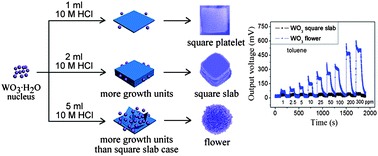Square slab-like and flower-like hydrated tungsten oxide three-dimensional architectures were synthesized by acidic precipitation of sodium tungstate solution at mild temperature. Techniques of X-ray diffraction, scanning electron microscopy, thermogravimetric-differential thermalgravimetric analysis, and transmission electron microscopy were used to characterize the structure and morphology of the products. The experimental results show that the square slab-like and flower-like WO3·H2O architectures can be obtained by addition of a varying amount of 10.0 M HCl solution. The corresponding tungsten oxide three-dimensional architectures were obtained after calcinations at 400 °C. Finally, the obtained WO3 three-dimensional architectures were used as sensitive materials in the experiments. Compared with WO3 square slabs, the as-prepared WO3 microflowers exhibit a good response and reversibility to some organic gases, such as toluene and acetone. The responses to 100 ppm toluene and acetone are 16.7 and 17.4, respectively, at a working temperature of 320 °C. In addition, the sensors also exhibit a good response to ethanol, methanol and n-butanol, which indicates that the flower-like WO3 nanostructures are highly promising for applications of gas sensors.

